Jazz Up Ubuntu’s Default Look With Custom Themes
Ubuntu
Key Takeaways
- Install GNOME Tweaks and Extension Manager.
- Set up .themes and .icons folders to store custom themes and icons for GNOME Tweaks.
- Download themes from GNOME-LOOK.ORG, apply them using GNOME Tweaks, or terminal method for system-wide installation.
Are you tired of Ubuntu’s default plain look? Is changing wallpapers and accent colors not scratching that customization itch? Well, in this guide I share a detailed overview of how to install custom themes to make your Ubuntu PC look amazing.
Install GNOME Tweaks and GNOME Extension Manager
Ubuntu is powered by the GNOME desktop environment, which means you’ll need GNOME Tweaks and GNOME Extension Manager to make any changes to how the distro looks and feels. Neither of the two tools come pre-installed with Ubuntu, but you can easily download them from the Ubuntu App Center—just remember to switch to Debian Packages instead of Snap Packages. Alternatively, you can also open the terminal (Ctrl+Alt+T) and type this command:
sudo apt install gnome-tweaks gnome-shell-extension-manager
With GNOME Tweaks, you get access to advanced appearance settings which let you switch between different themes, icons, cursor styles, and much more. However, to enable theming support on Ubuntu, you need to download the User Themes extension. To do this, open the GNOME Extension Manager, go into the Browse tab, search for User Themes, and install it.
With GNOME Tweaks and the User Theme Extension working, you now need to set up dedicated folders for storing the themes.
Set Up The Theme Folders
Here’s something that tripped me up when I first started theming: Ubuntu needs specific folders for your custom themes and icons. Once the themes and icons are moved to these folders, it becomes visible to GNOME Tweaks, and you can apply them on your system. Now, sometimes these folders might not be present by default, in which case you need to create them. To do so, simply open the File Manager, head into the Home directory, and create a .themes folder and a .icons folder.
Notice the dot(.) prefix to the folder names. This makes the folders hidden. You can view all hidden folders in a directory by hitting Ctrl+H in your file manager. All themes and icon packs moved to these folders will be available to the current user.
If you want to install themes or icon packs and make them available to all users, you’ll need to move them to
/usr/share/themes
and
/usr/share/icons
folder. I share how to do this in a later section.
Downloading Themes and Icons
Now that you’re done setting up all the prerequisites, it’s time to start downloading themes and icon packs. To do this, we will be heading to the premier source for GNOME themes and customization elements: Gnome-look.org. Simply open the website and jump into the GTK3/4 Themes section to view over 1500+ themes. Alternatively, you can visit the Full Icon Themes section or Cursors section to find icon packs and cursor themes respectively. It shows all the newly released stuff first, but you can switch to the Ratings tab to view the ones that most users love.
For the sake of this demonstration, I’ll download the Fluent GTK Theme, Tela Icon Theme, and the Bibata Modern Ice cursor. The main page will show you information about each of the products. The developer or designer usually includes necessary information regarding compatibility issues or installation instructions on this page.
Now, to download each of the files, you can head into the files tab and click the download button. Alternatively, some of the themes will have a GitHub page mentioned right below the title. You can visit the GitHub page to get more comprehensive documentation and download it from there.
Downloading and installing themes from GitHub usually involves using the terminal, which will give you granular control over the themes and how they change your PC.
Installing and Applying Your New Themes
Once you have downloaded the files, you’ll need to extract them and move them into the .themes or .icons folder respectively. Once done, head into GNOME Tweaks, go to the Appearance tab and select the theme as the Shell and Legacy Applications. To change icons and cursors, adjust those respective settings in GNOME Tweaks. Once selected, you’ll see your Ubuntu desktop transform!
If the new theme or icon pack doesn’t appear, try restarting GNOME Tweaks. Additionally, ensure the folder hierarchy is correct: the theme or icon pack folder should be directly inside .themes or .icons without any extra subfolders. For example, if the extracted folder contains separate “Dark” or “Light” subfolders, move those directly into the .themes folder. This structure is essential for GNOME Tweaks to recognize and apply the theme or icons properly.
The Shell theme customizes the look of the GNOME Shell itself, which includes the top bar, system menu, and notifications. The Legacy Applications Themes apply to the majority of GTK-based apps and change the appearance of window decorations, buttons, sliders, and other UI elements.
For system-wide installation (making themes available to all users), move the extracted files to /usr/share/themes or /usr/share/icons using the terminal. Just enter the following commands into the terminal:
sudo mv [extracted-theme-folder] /usr/share/themes
sudo mv [extracted-icon-folder] /usr/share/icons
Replace [extracted-theme-folder] and [extracted-icon-folder] with the actual folder names of your downloaded themes and icons. This will make them accessible to all users on the system.
With Ubuntu 22.04 and later, you might notice that themes don’t apply across all apps, specifically the system apps like Settings, File Manager, etc. This is because the newer GTK 4 apps tend to ignore custom themes.
Installing Themes Using The Terminal
Instead of installing themes by moving them into the .themes folder, you can also install them using your terminal. This specifically works if you download the GitHub version of a theme. For example, I downloaded a GitHub theme—WhiteSur-gtk-theme on Ubuntu to make it look like macOS, which I then had to install using the terminal to access all the fine-tuning options.
Overall, if you don’t feel comfortable using the terminal, there’s no necessity to use it. As I have shown, you can simply download a theme file, extract it, and move it to the corresponding folder and install it on your Ubuntu PC. The GitHub themes and the terminal-based installation process are there to help advanced users have better control over the specifics of the installation. Also, the terminal method is necessary if you wish to theme your Flathub apps.
Theme Recommendations to Try
Of the many GTK themes available on GNOME Looks, these seven are my personal favorites:
- Orchis: A material design theme with light/dark variants and multiple accent colors.
- WhiteSur: A polished macOS-style theme with smooth animations and detailed widgets.
- Fluent: Adapts Windows 11’s interface design for GNOME desktop environments.
- Nordic: Dark theme featuring a distinctive blue-grey color palette with subtle gradients.
- Layan: Material design with rounded corners in light and dark variants.
- Sweet: Bold color choices with striking dark variants.
- Dracula: Implementation of the popular Dracula color scheme for GNOME.
All of these themes bring a polished and professional design to help you customize and ideally personalize your Ubuntu PC. That said, if you wish to take your customization game to the next level, and potentially make Ubuntu more useful and feature rich, I’d strongly recommend experimenting with different GNOME extensions.
Custom themes offer endless possibilities to transform your Ubuntu desktop. Whether you prefer the sleek look of Windows 11, the polish of macOS, or something uniquely yours, theming lets you craft your perfect workspace. So dive in, experiment with different styles, and make Ubuntu truly yours.



















